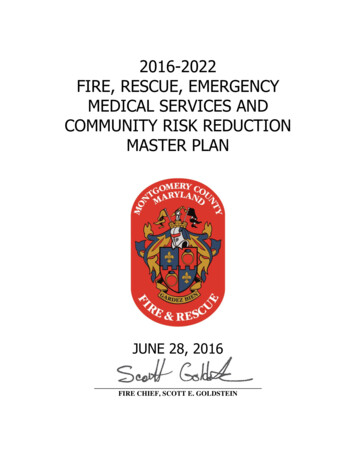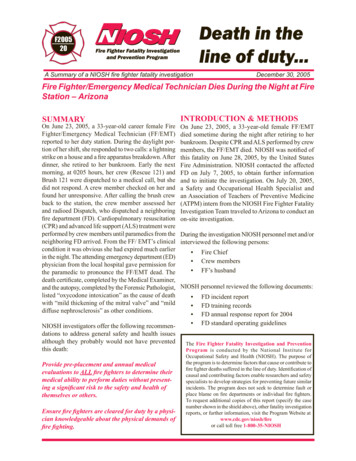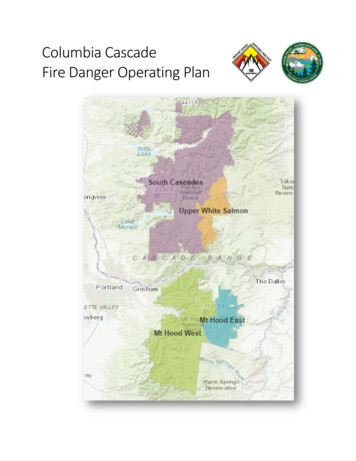
Transcription
Fire and Emergency Medical ServicesOperations and Data AnalysisFlint, MichiganDecember 2014FIREOperational AnalysisEMSCenter for Public Safety Management474 K Street, NW, Suite 702Washington, DC 20001www.cpsm.us – 716-969-1360Exclusive Provider of Public Safety Technical Assistance for theInternational City/County Management Association
General InformationAbout ICMAThe International City/County Management Association (ICMA) is a 100-year-old, nonprofitprofessional association of local government administrators and managers, with approximately9,000 members located in 32 countries.Since its inception in 1914, ICMA has been dedicated to assisting local governments in providingservices to its citizens in an efficient and effective manner. Its work spans all of the activities of localgovernment—parks, libraries, recreation, public works, economic development, code enforcement,brownfields, public safety, etc.ICMA advances the knowledge of local government best practices across a wide range of platformsincluding publications, research, training, and technical assistance. ICMA’s work includes bothdomestic and international activities in partnership with local, state, and federal governments aswell as private foundations. For example, it is involved in a major library research project funded bythe Bill &Melinda Gates Foundation and it is providing community policing training in Panamaworking with the U.S. State Department. It worked in Afghanistan assisting with buildingwastewater treatment plants and has teams in Central America working with SOUTHCOM toprovide training in disaster relief.Center for Public Safety Management LLCThe ICMA Center for Public Safety Management (ICMA/CPSM) is one of four Centers within theInformation and Assistance Division of ICMA providing support to local governments in the areas ofpolice, fire, EMS, emergency management, and homeland security. In addition to providingtechnical assistance in these areas we also represent local governments at the federal level and areinvolved in numerous projects with the Department of Justice and the Department of HomelandSecurity. In each of these Centers, ICMA has selected to partner with nationally recognizedindividuals or companies to provide services that ICMA has previously provided directly. Doing sowill provide a higher level of services, greater flexibility, and reduced costs in meeting member’sneeds as we will be expanding the services that ICMA can offer to local government is expanding.For example, The Center for Productivity Management (CPM) is now working exclusively with SAS,one of the world’s leaders in data management and analysis. And the Center for StrategicManagement (CSM) is now partnering with nationally recognized experts and academics in localgovernment management and finance.The Center for Public Safety Management, LLC (CPSM) is the exclusive provider of public safetytechnical assistance for ICMA and continues to provide training and research for the association’smembers and represents ICMA in its transactions with the federal government and other publicsafety professional associations.CPSM’s local government technical assistance experience includes workload and deploymentanalysis, using our unique methodology and subject matter experts to examine departmentorganizational structure and culture, identify workload and staffing needs as well as industry bestFire-EMS Operations and Data Analysis, Flint, Michiganpage ii
practices. We have conducted over 175 such studies in 35 states and 135 communities ranging insize from 8,000 population, in Boone, Iowa, to 800,000 population, in Indianapolis, Ind.Thomas Wieczorek is the Director of the Center for Public Safety Management. Leonard Matareseserves as the Director of Research & Program Development. Dr. Dov Chelst is the Director ofQuantitative Analysis. Joseph Pozzo is the Senior Manager for Fire/EMS.MethodologyThe Center for Public Safety Management team follows a standardized approach to conductinganalyses of police, fire, and other departments involved in providing public safety services to thepublic. We have developed this standardized approach by combining the experience sets of dozensof subject matter experts in the areas of police, fire, and EMS. Our collective team has more than onehundred years of conducting research in these areas for cities in and beyond the United States.The reports generated by the operations and data analysis team are based upon key performanceindicators that have been identified in standards and safety regulations and by special interestgroups such as the International Association of Chiefs of Police (IACP), International PoliceAssociation, the International Association of Fire Chiefs (IAFC), the International Associations ofFire Fighters (IAFF), and the Association of Public Safety Communication Officials International,and through the Center for Performance Measurement of ICMA. These performance measures havedeveloped following decades of research and are applicable in all communities. For that reason,comparison of reports will reveal similar reporting formats, but each community’s data areanalyzed on an individual basis by the CPSM specialists and represent the unique information forthat community.The CPSM public safety management team begins most projects by extracting calls for service andraw data from a public safety agency’s computer-aided dispatch system. The data are sorted andanalyzed for comparison to nationally developed performance indicators. These performanceindicators (e.g., response times, workload by time, multiple-unit dispatching) are valuablemeasures of agency performance regardless of departmental size. The findings are shown in tablesand graphs organized in a logistical format. Despite the size and complexity of the documents, aconsistent approach to structuring the findings allows for simple, clean reporting. The categoriesfor the performance indicators and the overall structure of the data and documents follow astandard format, but the data and recommendations are unique to the organization under scrutiny.The team conducts an operational review in conjunction with the data analysis. The performanceindicators serve as the basis for the operational review. The review process follows a standardizedapproach comparable to that of national accreditation agencies. Prior to the arrival of an on-siteteam, agencies are asked to provide the team with key operational documents (e.g., policies andprocedures, asset lists, etc.). The team visits each locality on-site to interview agency managementand supervisory personnel, rank-and-file officers, and local government staff.The information collected during the site visits and through data analysis results in a set ofobservations and recommendations that highlight strengths, weaknesses, opportunities, andthreats of the organizations and operations under review. To generate recommendations, the teamFire-EMS Operations and Data Analysis, Flint, Michiganpage iii
reviews operational documents; interviews key stakeholders and observes physical facilities; andreviews relevant literature, statutes and regulations, industry standards, and other informationand/or materials specifically included in a project’s scope of work.The standardized approach ensures that the Center for Public Safety Management measures andobserves all of the critical components of an agency, which in turn provides substance tobenchmark against localities with similar profiles. Although agencies may vary in size, priorities,and challenges, there are basic commonalities that enable comparison. The approach also enablesthe team to identify best practices and innovative approaches.In general, the standardized approach adopts the principles of the scientific method: We askquestions and request documentation upon project start up; confirm accuracy of informationreceived; deploy operations and data analysis teams to research each unique environment; performdata modeling; share preliminary findings with the jurisdiction; assess inconsistencies reported byclient jurisdictions; follow up on areas of concern; and communicate our results in a formal, writtenreport.CPSM Project ContributorsThomas J. Wieczorek, DirectorLeonard A. Matarese, Director of Research and Program DevelopmentDov N. Chelst, Ph.D., Director of Quantitative AnalysisJoseph E. Pozzo, Senior Manager for Fire and EMSGerard Hoetmer, Senior AssociateGang Wang, Ph.D., Senior Quantitative AnalystSarita Vasudevan, Quantitative AnalystDennis Kouba, EditorFire-EMS Operations and Data Analysis, Flint, Michiganpage iv
ContentsGeneral Information .iiAbout ICMA . iiCenter for Public Safety Management LLC . iiMethodology. iiiCPSM Project Contributors . ivContents .vCity of Flint, Michigan . 1Executive Summary. 7Recommendations and Considerations . 7Organizational Analysis . 13Organization and Structure. 13Public Safety Administrative Model. 16Internal Planning . 17FFD Fiscal Perspective . 21Fire Risk Perspective . 22Demand for Service. 22City of Flint Risk and Assessing Risk . 25The Insurance Services Office Community Grading Schedule . 32Target Hazards and Vacant Structures . 34Fire Prevention/Investigation . 36Operational Analysis . 38Operational Staffing and Deployment . 38Current Staffing and Deployment . 38Staffing Factor . 39Staffing Alternatives. 41Current Station and Response Time Analysis . 42Emergency Medical Services. 50Alternative EMS Service Delivery Models . 51Training and Preparation . 51Appendix I: Data and Workload Analysis . 54Introduction . 54Methodology. 54Aggregate Call Totals and Dispatches . 56Fire-EMS Operations and Data Analysis, Flint, Michiganpage v
Workload by Individual Unit—Calls and Total Time Spent . 69Analysis of Busiest Hours . 74Dispatch Time and Response Time . 76Attachment I: Workload of Support Units . 92Attachment II: Property and Content Loss Analysis for Structure and Outside Fire Calls . 93Attachment III: Actions Taken Analysis for Structure and Outside Fire Calls . 94Attachment IV: Correspondence between NFIRS Incident Type and Call Type . 95Fire-EMS Operations and Data Analysis, Flint, Michiganpage vi
City of Flint, MichiganThe city of Flint, Michigan is the county seat of Genesee County and is located approximately sixtymiles northwest of Detroit. Flint has a land area of approximately 33 square miles. It has beenranked the 7th largest city in Michigan. In 2013, the city’s estimated population was 99,763. 1 Flintis close to major airports, numerous highwaysystems, and rail service. It has state-of-the-arthealthcare providers, as it is served by HurleyMedical Center, McLaren Regional MedicalCenter, and Genesys Regional Medical Center,to name a few. 2Flint was the birthplace of General Motors andthe United Auto Workers. Flint is home to avariety of industries, including manufacturing,retail, healthcare, and wholesalers, to name afew. Flint has gradually developed into a“college town” with the presence of KetteringUniversity, University of Michigan-Flint, MottCommunity College, and Baker College. 3The city offers well-maintained parks, greenspaces, and waterways, and it has a wide arrayof recreational opportunities such asskateboarding, golf, bicycling, and hiking. Thecity islocated within thirty miles of state and recreational game areas. 4There is also an emphasis on arts and culture.Part I, Article III, Section 3-101 of the charter of the city of Flintestablishes that the city council is the legislative body of thegovernment. The city is run via a strong mayor-council form ofgovernment, and is divided into nine wards. Section 3-102 of thecharter provides that each council member elected from his/herdistrict will serve a four-year term. 5 The city council elects apresident from its membership to serve as presiding officer and avice president to serve in the absence of the president. Section 4-101 of the charter provides thatthe mayor will serve as the chief executive officer of the city, and pursuant to Section 4-201, communities-at-a-glance/#flint3 es-at-a-glance/#flint4 %20.pdf5 Charter, City of Flint Michigan.12Fire-EMS Operations and Data Analysis, Flint, Michiganpage 1
approval of the council, shall appoint a chief administrative officer. The chief administrative officer(city administrator) directs and supervises the day-to-day management of city government.At the time of this operational analysis, the city was, pursuant to Public Act 436 of 2012, the LocalFinancial Stability and Choice Act, operating under an emergency manager. This Act was designedto safeguard and assure the financial accountability of local units of government and schooldistricts. 6 Flint has been placed into state-level financial receivership and is one of seventeenmunicipalities and/or school districts in Michigan operating under this state legislation.As previously mentioned, the city of Flint has an estimated 2013 population of 99,763. According tothe 2010 U.S. Census, the city’s population that year was 102,400, with a demographic make-up asfollows: 37.4 percent white; 56.6 percent African-American; 0.5 percent American Indian andAlaskan Native; and 0.5 percent Asian. Of the population that is white, 3.9 percent is Hispanic orLatino. Of the 2010 population, 8 percent were under the age of 5 and 10.7 percent were above theage of 65. 7The median household income in Flint in 2008-2012 was 26,339, with 39.7 percent of thepopulation living below the poverty level in the same data period. There were 41,045 householdsfor this period with the average owner-occupied housing unit valued at 50,500. There were 51,321total housing units. 8 Lastly, there are 2.46 persons per household.The city’s population peaked at roughly 200,000in the 1960s, before a decline in industry beganto plague Flint and the surrounding area. The2013 U.S. Census Bureau-estimated currentpopulation (99,763) is down from 102,434 in2010 and 124,987 in 2000. This amounts to apopulation decrease of 20.2 percent between2000 and 2013.The population loss followed the loss of majoremployers. The decline of General Motors dealt aparticularly devastating blow. In the late 1970s,GM had some 80,000 local employees; by 2010,large GM divisions in the city — including Buick, Fisher Body, and AC Delco Sparkplugs — hadclosed their doors, leaving fewer than 8,000 local GM employees. The massive layoffs had a rippleeffect on other industries, leaving almost no sector of the economy untouched while puttingthousands of additional residents out of work. By 2010, the unemployment rate in Flint hadreached almost 20 percent. Many residents left to seek employment opportunities elsewhere,leaving entire neighborhoods nearly 21-1751 51556-201116--,00.htmlU.S. Census Bureau, State & County QuickFacts, Flint, 6/2629000.html8 Ibid.67Fire-EMS Operations and Data Analysis, Flint, Michiganpage 2
The vacant Buick City remains abrownfield — the largest brownfieldin the United States. People have fledthe city; their abandoned homes,businesses, and properties havefallen into disrepair. This oncethriving city known as the capital ofthe auto industry has now becomeknown better for its crime, rising tothe top of Business Insider’s list of themost dangerous cities in America. 9Flint’s economic troubles continue toplague the community. According tothe Bureau of Labor Statistics, Flint’sunemployment rate in July 2014 was9.3 percent, well above both the state (7.7 percent) and national average (6.2 percent). Perhapseven more telling is the fact that 39.7 percent of Flint’s residents live below the poverty level. 10The economic woes have naturally had a devastating impact on the city’s operations, and Flintcontinues to face significant financial challenges. Plummeting property and income tax revenues,coupled with significant increases in legacy costs (especially pension and retiree health care); haveresulted in a gap between revenues and expenses. The city has been in state receivership sinceDecember 2011, and the city’s five-year financial plan paints a dire picture for the future:“Unfortunately, the financial forecast for the next several years beyond FY16 shows a continuinggap between projected revenues and expenses. Within the next few years, without significantmeans to identify and collect additional revenues, or to further reduce the cost basis, the city ofFlint will be extremely challenged to provide even the most basic of city services.” 11The city has been struggling to turn around its finances, and there has been some success. Thedeficit at the end of FY12 was 19.1 million; at the end of FY13, the city had succeeded in reducingthe deficit to 12.9 million. In addition, the city’s cash position had improved, and the city put inplace an appropriately balanced budget that was expected to further reduce the deficit. As shown inFigures 1 and 2, the FY15 revenues are projected to be 165.1 million and expenditures 162.2million, and the FY16 revenues are projected to be 169.5 million and expenditures 166.6 million.See: Christina Sterbenz and Erin Fuchs, “How Flint, Michigan, Became the Most Dangerous City in America,”June 16, 2013. an-dangerous-2013-6.10 U.S. Census Bureau, State & County QuickFacts, Flint, 6/2629000.html11 City of Flint 5-Year Financial Plan, page 2. 5 FY16Adopted Budget Document.PDF.9Fire-EMS Operations and Data Analysis, Flint, Michiganpage 3
Figure 1: City of Flint FY 15 and FY 16 Revenue–All FundsFigure 2: City of Flint FY 15 and FY 16 Expenses–All FundsFire-EMS Operations and Data Analysis, Flint, Michiganpage 4
Reaching these financial goals has not been easy. There has been a significant reduction in citystaffing and, as a result, in services for citizens. The city has also led efforts to diversify the economyand attract new industry. Local foundations have funded renovation projects along downtown’sSaginaw Street. In addition, 2014 has seen a drop in violent crime.Like Detroit and other cities coping with widespread urban blight, Flint has undertaken an effortplan to tear down abandoned homes and other structures and return the land to nature — an effortthat is intended to reduce crime and to concentrate the dwindling population in a smaller servicearea. 12 To date, federal grant funding has been used to demolish about 1,500 properties, but thereremain roughly 3,000 vacant residential structures. The remaining vacant structures create impactson public safety services that range from incendiary fires to havens for criminal activities. Figure 3illustrates the concentration of vacant structures throughout the city.12See Tom Leonard, “US Cities May Have to be Bulldozed in Order to Survive,” The Telegraph, June 12, 2009.Fire-EMS Operations and Data Analysis, Flint, Michiganpage 5
Figure 3: Concentration of Vacant PropertyFire-EMS Operations and Data Analysis, Flint, Michiganpage 6
Executive SummaryThe Center for Public Safety Management, LLC (CPSM) was retained by the city of Flint to completea comprehensive analysis of the city’s fire department. This analysis is designed to provide the citywith a thorough and unbiased review of services provided by the Flint Fire Department (FFD). Aswell, the report provides information for how the city, based on funding and the management ofstaffing and deployment of resources, can better provide fire and EMS first response services fromcurrent fire stations. The report further provides a benchmark of the city’s existing service deliveryperformance as analyzed in the accompanying comprehensive data analysis, which was performedutilizing information provided by the FFD. This data analysis in itself provides significant value to thecity as the city now has a workload analysis from which to move forward with future planning efforts.Also included in this report is the use of geographic information systems (GIS) data mapping tosupport the operational discussion and recommendations.During the study, CPSM analyzed performance data provided by the FFD and also examinedfirsthand the department’s operations. Fire departments tend to deploy resources utilizingtraditional approaches, which are rarely reviewed. To begin the review, project staff asked the cityfor certain documents, data, and information. The project staff used this information/data tofamiliarize themselves with the department’s structure, assets, and operations. The providedinformation was also used in conjunction with the raw performance data collected to determine theexisting performance of the department, and to compare that performance to national benchmarks.These benchmarks have been developed by organizations such as the National Fire ProtectionAssociation (NFPA), Center for Public Safety Excellence, Inc., (CPSE), and the ICMA Center forPerformance Measurement. FFD staff was also provided an electronic shared information folder toupload information for analysis and use by the CPSM project management staff.Project staff conducted a site visit on August 13 and 14, 2014, for the purpose of observing firedepartment and agency-connected supportive operations, interviewing key department staff, andreviewing preliminary data and operations. Telephone conference calls were conducted as were email exchanges between CPSM project management staff and the city so that CPSM staff couldaffirm the project scope, and elicit further discussion regarding this operational analysis.Recommendations and considerations for continuous improvement of services are presented nextand in the order in which they appear in the report. CPSM recognizes there may berecommendations and considerations offered that have to be bargained, budgeted for, or for whichprocesses have to be developed prior to implementation.Recommendations and Considerations While discussing the organization with the fire chief and staff during the CPSM on-site visit,the fire chief discussed a reorganization of positions. This plan would include reallocatingthe EMS supervisor position back to field operations and the renaming of the primarycaption position to district commander. CPSM recommends an even closer look at theorganizational structure. As currently structured and proposed by the fire chief there aretwo levels of first-line supervision at the company level. CPSM recommends the FFD haveFire-EMS Operations and Data Analysis, Flint, Michiganpage 7
only one level of first-line supervision and further recommends, due to the limitednumber of available staffed companies, that this be at the lieutenant level and beassigned to each apparatus. As well, CPSM does not recommend the continuance of theapparatus operator II position classifications. Instead, as an efficiency measure, CPSMrecommends additional compensation for FF/EMTs only when they move up totemporarily fill in an apparatus operator position. Further, whether the middlemanagement level is titled primary captain or district commander, it is important that thislevel remain in place, especially with limited and available administrative staff andcommand positions, considering the day-to-day responsibilities to manage and lead theoperational component of the agency. Lastly CPSM recommends the sergeant/fireinspector position be re-designated as a hazards mitigation officer to perform andmaintain a risk analysis and vulnerability study of the community (discussed later inthis report), work with the appropriate agencies to assist with the continued mitigationof the vacant housing issues confronting the city, and focus on target hazards and prefire planning efforts in conjunction with other fire prevention-related activities. Arecommended organizational chart for the FFD is presented as Figure 6. Efficiencies that may be realized through a public safety administrative model includeconsolidating all administrative, financial, and technical services and support for core publicsafety functions under the umbrella of one director. A true efficiency in this model is theelimination of one or more senior staff positions in one or both of the public safety agencies.It is inefficient to keep both the police and fire chief and hire an additional public safetydirector, unless funding is available to sustain that model. This is not the case in Flint. CPSMrecommends that prior to moving to this model both agencies must have in place asenior-level position, or must preserve a senior level position in the case of aretirement, to ensure both agencies have a leadership component and proven subjectmatter expert to serve as a division director. The public safety director would be anexisting and funded senior level position to lead the entire public safety agency. In a review of the recent quarterly report on the citywide strategic plan, it was found thatthe FFD reported on its fourteen key objectives, with seven listed as incomplete, three asnot started, and four as completed. For those listed as completed, however, there is nolisting of activities or discussion of the effectiveness or efficiency with which the objectiveswere completed, although there may exist individual reports or information transmittedverifying the completion. As an example, one key objective is “turnaround time for FireInspections to be five days or less.” A true measure of this will list t
Medical Center, McLaren Regional Medical Center, and Genesys Regional Medical Center, to name a few. 2 Flint was the birthplace of General Motors and the United Auto Workers. Flint is home to a variety of industries, including manufacturing, retail, healthcare, and wholesalers, to name a few. Flint has gradually developed into a











